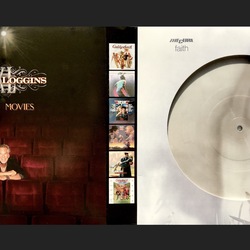TECHNICOLOUR vs MONOCHROME
Author: Bruce Jenkins Date Posted:16 July 2021

There is a tendency to characterise decades with a single image. Thus, the Sixties were paisley, flares defined the Seventies and the Eighties were neon bright. Of course it could never be as simple as that; we adopt labels as a way to summarise, with all the shrinkage that implies. Take British band The Cure, for example. Much of their popular recognition came from a handful of upbeat singles ( "The Love Cats", "Let’s Go To Bed") yet their musical reputation was built on the goth period and the three albums released between 1980 and 1982. It is the middle LP, Faith, that presents The Cure in all their downcast glory.
Pick up Faith and you are greeted by a washed out monochrome photo of a fog-shrouded English church. It is a weeping, bleak image, well-matched to the mood of the music. Gloom, of course, was exactly what the goth scene projected, as the signature fashion statement of black clothes and pale skin so strikingly demonstrates. But giving the music time and space, making room to explore this B&W world, can reveal much to enjoy.
Faith opens with "The Holy Hour". The instrumentation is sparse, the atmosphere dreamy yet unsettling. Robert Smith’s voice does not even enter until the one-and-a-half minute mark and when it does it is back in the mix, almost like the human presence is distant, lost in the fog. A tolling bell signifies the end of the piece. But then the pace accelerates, with (the modestly successful single) "Primary". This song has lots of effects in play, and rattles along at quite a clip like a goth REM. That’s the way the album unfolds; within its austere world there are eight shades of grey ranging from melancholy ("The Drowning Man") to enraged ("Doubt"), while the lyrics canvas ageing, death and isolation. Yes, it is downbeat. Yes, it is compelling. Yes, it is rather brilliant. Perfect for a chilly winter’s afternoon or late night brooding.
In startling contrast to the austere pessimism of the oh-so-English Cure we have Hollywood’s glitz and high-octane energy, represented in all its Eighties technicolour glory by Kenny Loggins At The Movies. This 2021 RSD release gathers together Loggins’ film music songs into one bright and breezy thirty-six minute blast of pop exuberance.
The LP opens with "I’m Alright" from Caddyshack (1980), Loggins’ first foray into songs for movies. The single quickly proved what a fine career move this was, reaching the US Top 10. Things soon got even better for the man who came to be dubbed "King of the Movie Soundtrack" (we’re not sure who awarded him this regal title). Loggins’ next film commission was Footloose. You probably know the rest: the title song was a #1 hit in a many countries (including the US, Australia and New Zealand) and remains a staple of Classic Rock FM radio to this day.
Was Kenny Loggins ground down by the demands of movie songwriting? Not in the slightest! Top Gun came next, the soundtrack LP being a massive seller on the back of "Danger Zone" and "Playing with the boys", both featured on Kenny Loggins At The Movies. A couple more (less lauded) movies rounded out a massively successful decade for Mr Loggins.
Pondering that title, "King of the movie soundtrack", one cannot help thinking about another King, Elvis Presley, who not only starred in over thirty movies, but recorded soundtrack LPs for seventeen of them. How does "Jailhouse Rock" measure up against "Footloose"? We’ll leave that for you to debate, because we’re off to a party being thrown by the warden at the county jail. The prison band is there and maybe they will play some Cure covers.
© Bruce Jenkins 2021

